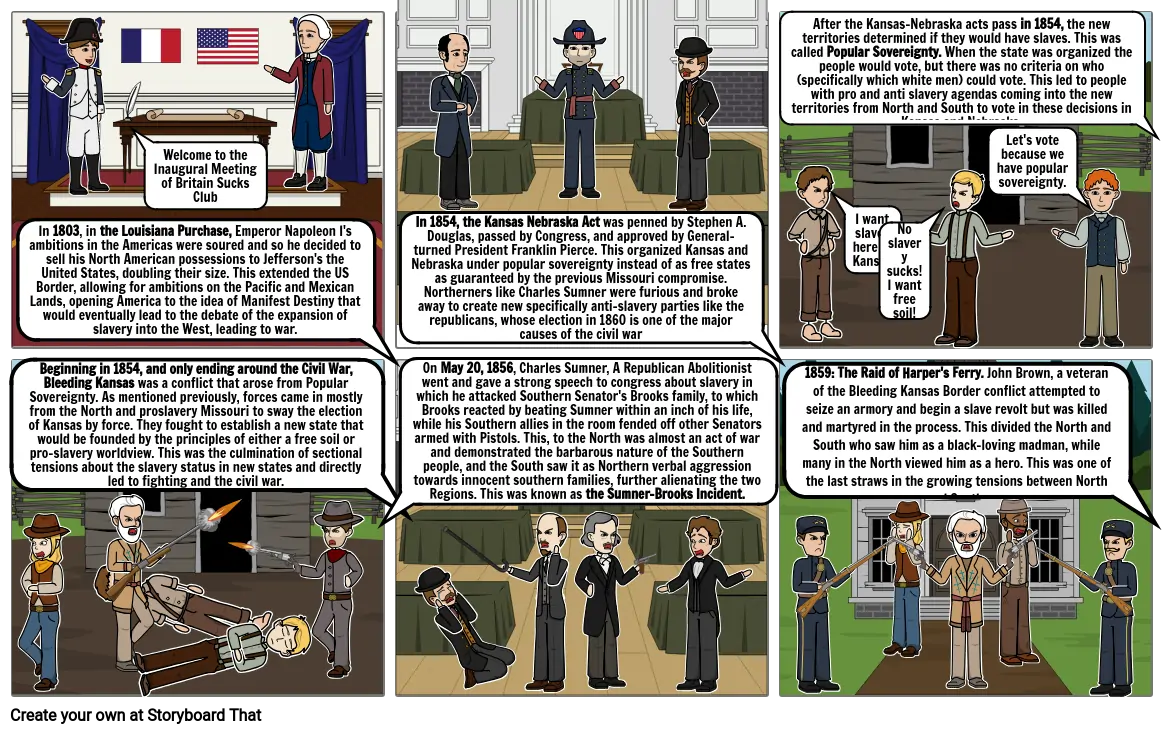US history 2

Storyboard Descripción
s
Texto del Guión Gráfico
- In 1803, in the Louisiana Purchase, Emperor Napoleon I's ambitions in the Americas were soured and so he decided to sell his North American possessions to Jefferson's the United States, doubling their size. This extended the US Border, allowing for ambitions on the Pacific and Mexican Lands, opening America to the idea of Manifest Destiny that would eventually lead to the debate of the expansion of slavery into the West, leading to war.
- Welcome to the Inaugural Meeting of Britain Sucks Club
- In 1854, the Kansas Nebraska Act was penned by Stephen A. Douglas, passed by Congress, and approved by General-turned President Franklin Pierce. This organized Kansas and Nebraska under popular sovereignty instead of as free states as guaranteed by the previous Missouri compromise. Northerners like Charles Sumner were furious and broke away to create new specifically anti-slavery parties like the republicans, whose election in 1860 is one of the major causes of the civil war
- After the Kansas-Nebraska acts pass in 1854, the new territories determined if they would have slaves. This was called Popular Sovereignty. When the state was organized the people would vote, but there was no criteria on who (specifically which white men) could vote. This led to people with pro and anti slavery agendas coming into the new territories from North and South to vote in these decisions in Kansas and Nebraska.
- I want slaves here in Kansas
- No slavery sucks! I want free soil!
- Let's vote because we have popular sovereignty.
- Beginning in 1854, and only ending around the Civil War, Bleeding Kansas was a conflict that arose from Popular Sovereignty. As mentioned previously, forces came in mostly from the North and proslavery Missouri to sway the election of Kansas by force. They fought to establish a new state that would be founded by the principles of either a free soil or pro-slavery worldview. This was the culmination of sectional tensions about the slavery status in new states and directly led to fighting and the civil war.
- On May 20, 1856, Charles Sumner, A Republican Abolitionist went and gave a strong speech to congress about slavery in which he attacked Southern Senator's Brooks family, to which Brooks reacted by beating Sumner within an inch of his life, while his Southern allies in the room fended off other Senators armed with Pistols. This, to the North was almost an act of war and demonstrated the barbarous nature of the Southern people, and the South saw it as Northern verbal aggression towards innocent southern families, further alienating the two Regions. This was known as the Sumner-Brooks Incident.
- 1859: The Raid of Harper's Ferry. John Brown, a veteran of the Bleeding Kansas Border conflict attempted to seize an armory and begin a slave revolt but was killed and martyred in the process. This divided the North and South who saw him as a black-loving madman, while many in the North viewed him as a hero. This was one of the last straws in the growing tensions between North and South.
Más de 30 millones de guiones gráficos creados

